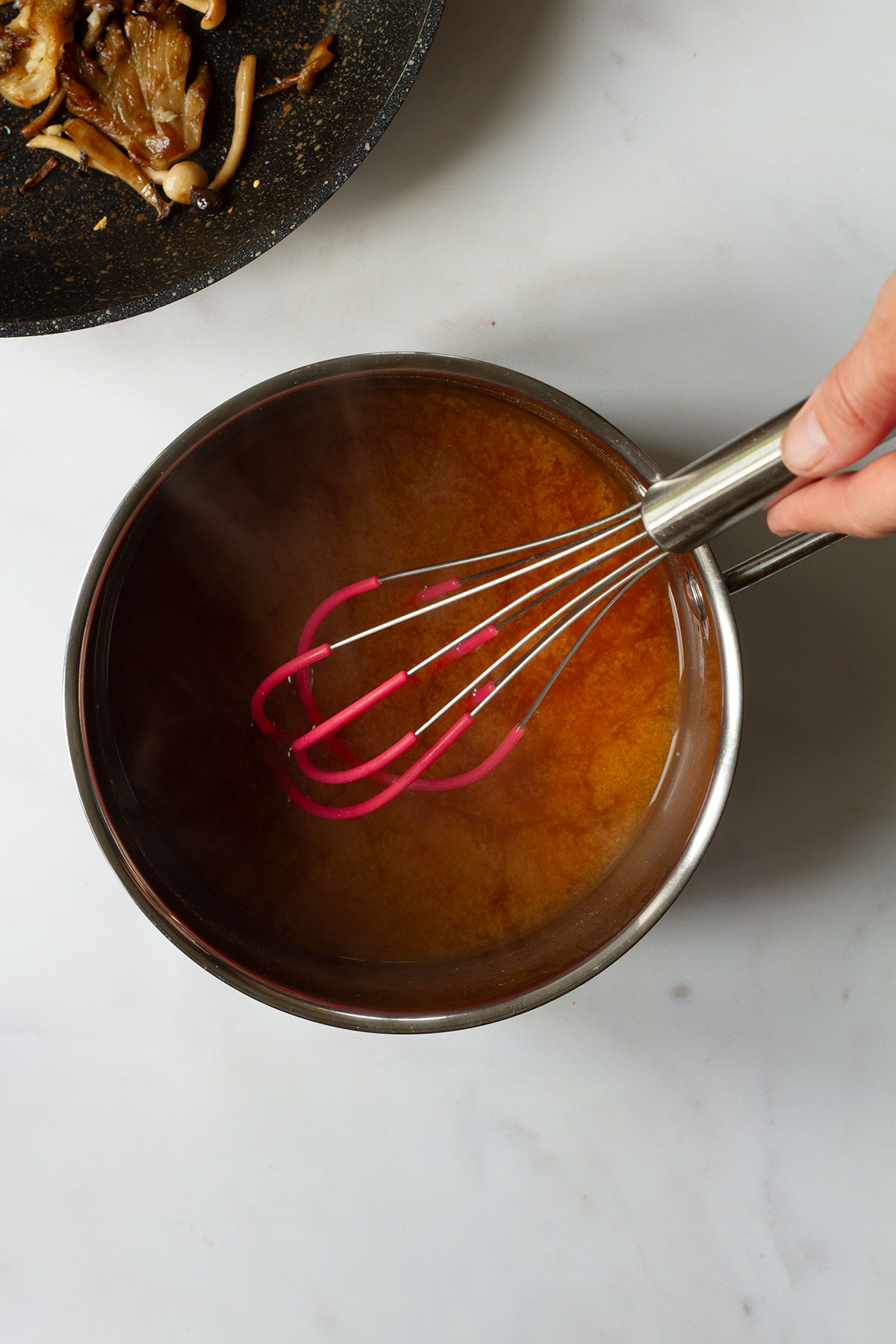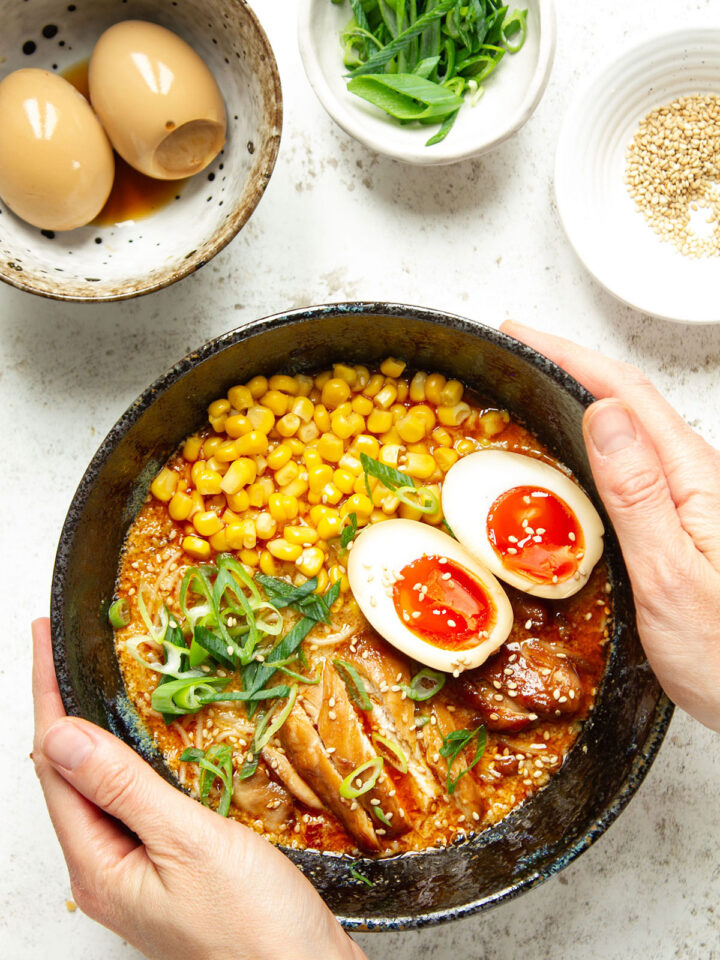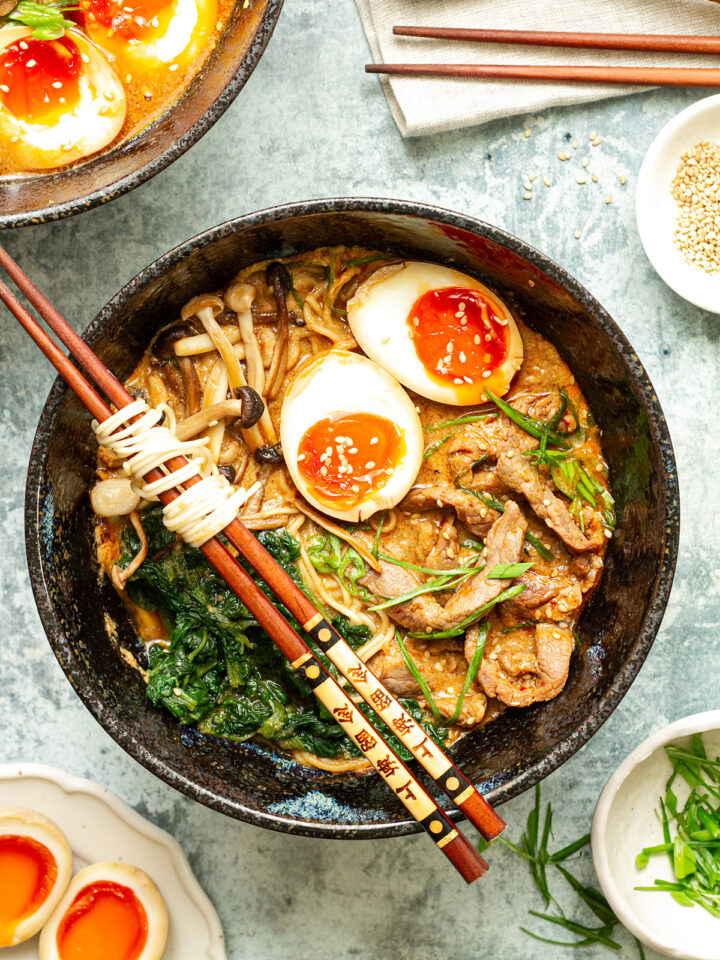Warming, nutritious and delightfully umami, whether you're in the mood for a classic Japanese miso mushroom soup or in search of a new twist, you've landed in the right place.

This recipe covers everything from which mushrooms, miso paste and dashi to use to serving suggestions, substitutions, tips, and add-ins to make it your own.
Whether you're looking to enjoy it as a side with other Japanese dishes like Chicken Tempura, or Miso Eggplant, or toss in some additional ingredients to transform it into a heartier meal we've got you covered.
Mushrooms infuse miso soup with that irresistible earthy umami flavour. Plus, they're super nutritious too. You can find more tasty and speedy mushroom recipes on my mushroom recipes page.
The post contains additional information and helpful tips to ensure the recipe turns out great the first time. Please use the link above to jump to the recipe card at the end if you are in a hurry!
Jump to:
- 5 reasons why you'll love this recipe:
- What is mushroom miso soup?
- 🛒 Key ingredients:
- Which are the best types of mushrooms to use for miso soup?
- Dashi
- Which miso paste to use?
- Substitutions & variations:
- 🧑🍳 Recipe steps
- 🍽️ Serving suggestions
- Expert Tips
- 🙋 Recipe FAQs
- 😋 More miso recipes
- 📖 Recipe
- Miso mushroom soup
5 reasons why you'll love this recipe:
- Warming and nutritious miso soup with umami mushrooms.
- Healthy and nutritious.
- Ready in 15 minutes.
- Uses 3 core ingredients.
- Adaptable. With lots of ways to add a unique twist and make it your own.
What is mushroom miso soup?
Mushroom miso soup is a variation of traditional Japanese miso soup which is made from a dashi broth (typically made with fish or seaweed), miso paste (fermented soybean paste), and various ingredients like tofu, seaweed, and green onions.
In mushroom miso soup, mushrooms take centre stage, providing a rich, earthy flavour and hearty texture. Common types of mushrooms used in this soup include shiitake, enoki, shimeji and oyster.
🛒 Key ingredients:
This tasty soup comes together with just three main ingredients. And I've got some extra suggestions if you're looking to jazz it up and turn it into a heartier meal.

- Mushrooms: While the traditional method involves simmering them in dashi, I prefer to enhance their flavour by sautéing them with garlic
- Dashi or veg stock
- Miso Paste
Optional extras:
- Soy sauce: for extra richness
- Cooked brown or wild rice
- Poached eggs
- Green onions or scallions
Which are the best types of mushrooms to use for miso soup?
The type of mushrooms can greatly affect the flavour and texture of the soup. Here are some of the best types of mushrooms to use in mushroom miso soup:
- Shiitake Mushrooms: Have a robust, earthy flavour and a meaty texture that adds depth and richness to the soup.
- Enoki Mushrooms: Have a delicate, almost sweet flavour and a long, slender appearance. They add a subtle, elegant touch to the soup and are often used for their unique texture.
- Oyster Mushrooms: Have a mild, slightly sweet flavour and a tender, velvety texture. They work well in miso soup and absorb the flavours of the broth nicely.
- Shimeji Mushrooms: Whether white or brown, they have a nutty flavour and a firm, slightly crunchy texture.
- Cremini or White Button Mushrooms: Have a milder flavour compared to shiitake or oyster mushrooms but are widely available and budget-friendly. They can be used with other mushrooms for a balanced flavour.
- Porcini Mushrooms: If you want to impart a deep, earthy, and umami-rich flavour to your miso soup, consider using dried porcini mushrooms. Rehydrate them before adding them to the soup for an intense mushroom essence.
For ease, I often use a packet of mixed Asian mushrooms that typically contains oyster and white & brown shimeji. Feel free to use a combination of mushrooms according to your personal preference.
Dashi
Dashi is a fundamental Japanese cooking stock or broth used as a base for many dishes, including soups, stews, and sauces. It is typically made by simmering ingredients like dried bonito flakes (katsuobushi), dried seaweed (kombu), and sometimes dried mushrooms or anchovies (Niboshi).
Here are the three types that are most commonly used to make miso soup. Feel free to choose one based on your personal preference.
- Kombu Dashi: Made by steeping dried kelp (kombu) in water. It has a subtle, delicate flavour and is often used for vegetarian miso soup.
- Katsuobushi (Bonito Flakes) Dashi: Made by simmering dried bonito flakes (shaved dried fish) in water. It has a stronger umami flavour and is commonly used in traditional miso soup recipes.
- Awase Dashi: A blend of kombu and katsuobushi dashi. This combination creates a balanced dashi with both umami depth and a hint of oceanic sweetness.
Store-bought dashi powder is the most convenient option. If you want to make your own dashi, I recommend reading Namiko Hairasawa Chen's How to Make Dashi Guide from Just One Cookbook, where you can also find a number of recipes for homemade dashi.
Which miso paste to use?
There are three types of miso paste that are commonly used in miso soup:
- White Miso (Shiro Miso): The mildest and sweetest type of miso paste with a light colour and a subtle, slightly sweet flavour. It works well in miso mushroom soup because it won't overpower the delicate flavours of the mushrooms. It's also the most readily available.
- Yellow Miso (Shinshu Miso or Awase Miso): Has a balanced flavour profile with a moderate level of saltiness and umami. It's a good choice if you want a slightly more robust flavour.
- Red Miso (Aka Miso): Has a deep, rich flavour and is the saltiest of the three and can be used in miso mushroom soup for a bolder, more intense flavour.
Miso has a long shelf life, but if you're uncertain about its freshness, you can refer to my "Does Miso Go Bad?" article for guidance.
Substitutions & variations:
Note that the recipe has not been tested with all the substitutions and variations below, so the results cannot be guaranteed.
- Use veg stock instead of dashi. This provides a different flavour profile compared to traditional dashi, but it can still result in a delicious and comforting soup. It's also a great way to make the soup vegetarian/vegan.
- Add rice and poached eggs to enjoy the soup as a full meal rather than a side.
- Noodle Mushroom Miso Soup: Include cooked soba, ramen, or udon noodles.
- Greens and Tofu: Enhance the nutritional value by adding leafy greens like spinach or kale and cubes of silken tofu.
- Spicy Mushroom Miso Soup: Add a kick by incorporating chilli paste, Sriracha, or red pepper flakes.
🧑🍳 Recipe steps
*Be sure to see the recipe card below for the full ingredients list & instructions! *
Step 1: Place a frying pan on a high heat, add the oil and fry the mushrooms until slightly brown. Reduce the heat to medium, add the garlic, fry for a couple more minutes until fragrant and set aside.

Step 2: Heat and add the dashi or stock on a medium heat until it starts to boil. Take the pan off the heat, whisk in the miso paste and add a little soy sauce (if using).

Step 3: Stir in the mushrooms and serve immediately.

Step 4: Add rice, poached eggs and green onions/scallions if desired.

🍽️ Serving suggestions
Traditionally, mushroom miso soup is served as an appetiser or side dish alongside other Japanese dishes like Japanese Grilled Mackerel, Chicken Tempura or Crunchy Roll Sushi.
However, with the addition or rice, noodles and boiled or poached eggs the soup can be served as a standalone meal.
Expert Tips
- Add the miso paste when the pan is off the heat. The miso loses its flavour when boiled.
- Use a whisk to combine the miso with the dashi and stock.
- Make it a stand-alone meal by adding rice or noodles and/or a poached egg.
🙋 Recipe FAQs
Miso soup may not be vegan due to its traditional use of dashi, which often contains animal-derived ingredients like bonito flakes and kombu. However, vegan versions can be easily prepared by using plant-based dashi or veg stock and vegan miso pastes.
Miso soup is primarily made from miso paste, which is fermented from soybeans, grains, or legumes. It is combined with dashi, a broth made traditionally from kombu and bonito flakes. Additional ingredients such as tofu, green onions, and vegetables are often added to create a flavourful and hearty soup.
Japanese people commonly consume miso soup as part of their daily meals. It is a staple of Japanese cuisine and is often enjoyed as a side dish for breakfast, lunch, and dinner. Miso soup is appreciated not only for its delicious flavour, but also provides essential nutrients and probiotics from the fermented miso paste.
Allow it to cool to room temperature, transfer it to an airtight container and store it in the refrigerator for up to 3 days. When reheating, use the stovetop or microwave, being cautious not to boil it, and adjust the seasoning as needed.

Did you try this recipe?
It would be really great if you could leave a comment and a star rating ⭐️. I would love to receive your feedback and know that other readers find it helpful too.
Don't forget to tag #knifeandsoulrecipes on Instagram or @knifeandsoul on Pinterest!
📖 Recipe

Miso mushroom soup
Equipment
Ingredients
- 1.75 cups (400 ml) dashi or vegetable stock (Note 1)
- 1-2 tbsp miso paste (Note 2)
- 1 tbsp soy sauce (optional)
- 1 tbsp butter
- 2 cups (170 g) mushrooms trimmed, cleaned and thinly sliced (Note 3)
- 2 cloves garlic crushed
Optional
- 2 servings cooked rice (note 1)
- 2 poached eggs
- scallions finely chopped
Instructions
- Set a frying pan to a high heat, add the oil and fry the mushrooms until slightly brown.
- Reduce the heat to medium, add the garlic, fry for a a couple more minutes until fragrant and set aside.
- Heat and add the dashi or stock on a medium heat until it starts to boil.
- Remove the pan from the heat, add the miso paste and whisk until combined.
- Add the cooked mushrooms to the soup and serve immediately.
- Optional: Add rice, poached eggs and scallions to turn it into a hearty meal.
Notes
- Dashi: You can use veg stock instead of dashi. This provides a different flavour profile compared to traditional dashi, but it can still result in a delicious and comforting soup. It's also a great way to make the soup vegetarian/vegan.
- Miso: Use white, yellow or red depending on your preference. Scroll up to the section on which miso paste to use to find out more.
- Mushrooms: For ease, I often use a packet of mixed Asian mushrooms that typically contains oyster and white & brown shimeji. Feel free to use a combination of mushrooms depending on your preference. Scroll up to the Which are the best types of mushrooms to use for miso soup? section for more information.








I made this recipe for the first time today and really enjoyed it. I would never have thought of adding egg to a soup but it worked really well. The soup had a delicate flavour which allowed the mushrooms to really pop. I was also happily surprised by how filling it was as someone who is always hungry! I used brown rice as didn't have any wild rice in and used brown chestnut mushrooms both of which which worked well. Would definitely make again and maybe try shitake mushrooms next time for a change.
Thank you for the comment, I'm really glad you enjoyed the soup. I have also made a soup with a few different types of mushrooms. I'm sure shitake will be yummy too!